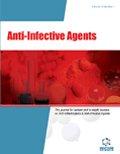Abstract
The effect of varying concentrations of Tween 80 on the antimicrobial potency of platensimycin and triclosan was investigated using both Streptococcus agalactiae (S. agalactiae) and methicillin-resistant Staphylococcus aureus (MRSA). In the presence of very low concentrations of Tween 80 (0.02%) both platensimycin and triclosan were rendered ineffective against S. agalactiae. A linear concentration-dependence was found with the antimicrobial activity of triclosan against MRSA showing a loss in effectiveness with increasing concentrations of Tween 80. Platensimycin, on the other hand, demonstrated improved antibiotic activity at higher concentrations of Tween 80. The differential effects of these two agents have implications for the regulation of lipids in Gram positive organisms and the viability of bacterial fatty acid synthesis inhibitors as antibiotics.
Keywords: Fatty acids, linezolid, methicillin-resistant Staphylococcus aureus, platensimycin, Streptococcus agalactiae, triclosan, Tween 80.
Anti-Infective Agents
Title:Bacterial Fatty Acid Synthesis: Effect of Tween 80 on Antibiotic Potency Against Streptococcus Agalactiae and Methicillin-Resistant Staphylococcus Aureus
Volume: 12 Issue: 1
Author(s): Dragan Krsta, Caron Ku, Ian T. Crosby, Ben Capuano and David T. Manallack
Affiliation:
Keywords: Fatty acids, linezolid, methicillin-resistant Staphylococcus aureus, platensimycin, Streptococcus agalactiae, triclosan, Tween 80.
Abstract: The effect of varying concentrations of Tween 80 on the antimicrobial potency of platensimycin and triclosan was investigated using both Streptococcus agalactiae (S. agalactiae) and methicillin-resistant Staphylococcus aureus (MRSA). In the presence of very low concentrations of Tween 80 (0.02%) both platensimycin and triclosan were rendered ineffective against S. agalactiae. A linear concentration-dependence was found with the antimicrobial activity of triclosan against MRSA showing a loss in effectiveness with increasing concentrations of Tween 80. Platensimycin, on the other hand, demonstrated improved antibiotic activity at higher concentrations of Tween 80. The differential effects of these two agents have implications for the regulation of lipids in Gram positive organisms and the viability of bacterial fatty acid synthesis inhibitors as antibiotics.
Export Options
About this article
Cite this article as:
Krsta Dragan, Ku Caron, Crosby Ian T., Capuano Ben and Manallack David T., Bacterial Fatty Acid Synthesis: Effect of Tween 80 on Antibiotic Potency Against Streptococcus Agalactiae and Methicillin-Resistant Staphylococcus Aureus, Anti-Infective Agents 2014; 12 (1) . https://dx.doi.org/10.2174/22113525113119990116
| DOI https://dx.doi.org/10.2174/22113525113119990116 |
Print ISSN 2211-3525 |
| Publisher Name Bentham Science Publisher |
Online ISSN 2211-3533 |
 50
50
- Author Guidelines
- Bentham Author Support Services (BASS)
- Graphical Abstracts
- Fabricating and Stating False Information
- Research Misconduct
- Post Publication Discussions and Corrections
- Publishing Ethics and Rectitude
- Increase Visibility of Your Article
- Archiving Policies
- Peer Review Workflow
- Order Your Article Before Print
- Promote Your Article
- Manuscript Transfer Facility
- Editorial Policies
- Allegations from Whistleblowers
- Announcements
Related Articles
-
Mechanism-Based Inactivation of Cytochrome P450 Enzymes: Chemical Mechanisms, Structure-Activity Relationships and Relationship to Clinical Drug-Drug Interactions and Idiosyncratic Adverse Drug Reactions
Current Drug Metabolism Calcium Antagonists: A Ready Prescription for Treating Infectious Diseases?
Current Topics in Medicinal Chemistry Clinical Pharmacogenetics and Potential Application in Personalized Medicine
Current Drug Metabolism Direct Evidence on the Immune-Mediated Spontaneous Regression of Human Cancer: An Incentive for Pharmaceutical Companies to Develop a Novel Anti-Cancer Vaccine
Current Pharmaceutical Design Monoterpenoid Geraniol Improves Anti-mycobacterial Drug Efficiency by Interfering with Lipidome and Virulence of Mycobacteria
Infectious Disorders - Drug Targets Pandemic of Atopic Diseases - A Lack of Microbial Exposure in Early Infancy?
Current Drug Targets - Infectious Disorders Novel Benzylidenehydrazide-1,2,3-Triazole Conjugates as Antitubercular Agents: Synthesis and Molecular Docking
Mini-Reviews in Medicinal Chemistry Biomarkers Associated with Vulnerable Atheromatous Plaque
Current Medicinal Chemistry Micro Arrays and Biochips: Applications and Potential in Genomics and Proteomics
Current Genomics A Review of QSAR studies to Discover New Drug-like Compounds Actives Against Leishmaniasis and Trypanosomiasis
Current Topics in Medicinal Chemistry Microwave: An Important and Efficient Tool for the Synthesis of Biological Potent Organic Compounds
Current Medicinal Chemistry Genotypic Characterization of Vancomycin-Resistant Enterococcus spp. In Tertiary Center, Iran
Infectious Disorders - Drug Targets Antimicrobial Precious-Metal Nanoparticles and their Use in Novel Materials
Recent Patents on Food, Nutrition & Agriculture Rheumatoid Nodules and Lung
Current Respiratory Medicine Reviews Synthesis and Antimicrobial Activity of N,N-Bis(2-hydroxylbenzyl)-1,2- ethanediamine Derivatives
Letters in Drug Design & Discovery Synthesis and Evaluation of Bis-pyrazoline Derivatives as Potential Antimicrobial Agents
Letters in Drug Design & Discovery Meet the Editorial Board:
Current Medicinal Chemistry Synthesis and Medicinal Applications of Benzimidazoles: An Overview
Current Organic Synthesis Meet Our Editorial Board Member
Drug Delivery Letters Burden of Multidrug Resistant Mycobacterium tuberculosis Among New Cases in Al-Madinah Al-Monawarah, Saudi Arabia
Infectious Disorders - Drug Targets


























